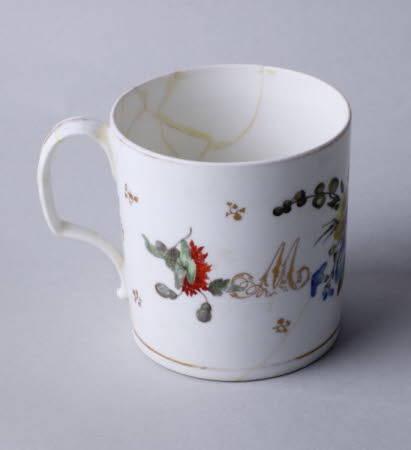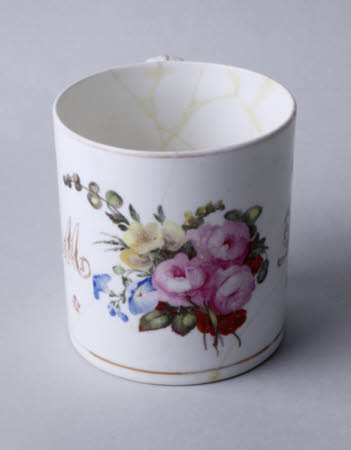Mug
Pinxton Porcelain Factory
Category
Ceramics
Date
1796 - 1799
Materials
Porcelain, paint and gilt
Measurements
117 mm (Height); 110 mm (Diameter)
Place of origin
Derbyshire
Order this imageCollection
Hill Top, Cumbria
NT 641505
Summary
Mug, soft-paste porcelain, cylindrical body, plain rim, the handle of a loop form with convex 'kicked' lower section, Pinxton, Derbyshire, 1796-99; painted in overglaze polychrome enamel by William Billingsley with three large pink roses, with blue convolvulus, yellow and red blooms, either side of this central posy are the gilt letters 'M' and 'D' in cursive script, a single blue and a red bloom flanking the handle; plain band of gilt above base, worn band of gilt below rim, small gilt stylised blooms intermittently on the body.
Full description
This mug, made by the Derbyshire porcelain factory at Pinxton, is part of the collection at Hill Top. Beatrix Potter purchased this farmhouse in the Lake District village of Near Sawrey in 1905, using the profits from her books. After her marriage to William Heelis in 1913, Beatrix relocated permanently to Sawrey. The couple made nearby Castle Cottage their home, but Beatrix spent as much time as she could at Hill Top. As well as a space for work and creativity – and the location for many of her famous tales – it became an intensely personal sanctuary for Beatrix. Beatrix knew exactly how she would decorate Hill Top and arranged its interiors carefully and deliberately. She wrote: ‘I would have old furniture…it is not as expensive as modern furniture, and incomparably handsomer…’ Once she had renovated the farmhouse, she filled it with examples of local furniture and treasured heirlooms, like her grandmother’s warming pan and a set of plates decorated with designs by her father. The mug is described in a 1946 inventory of Hill Top, made after Beatrix’s death and following its preparation for the visiting public: ‘Fine large china mug, with flowers painted in brilliant colours decorating each side. Note pasted on bottom, “Painted by W. Billingsley, Pinxton.” The mug was displayed in the corner cupboard of her Sitting Room, as part of a dense, eclectic arrangement of ceramics. The Sitting Room was a fairly informal space on the upper floor of Hill Top that was used by Beatrix for entertaining friends and family. William Billingsley is best known for the beautiful flowers he painted onto porcelain. He was apprenticed as a porcelain painter at Derby, before establishing the Pinxton Porcelain Factory in 1796 with his partner, John Coke. Billingsley remained at Pinxton until 1799, when he left to begin working as an independent decorator, and was later associated with factories including Worcester, Torksey, Coalport and Nantgarw.
Marks and inscriptions
Underside of base: PINXTON, painted by W. BILLINGSLEY (Labelled underneath)
Makers and roles
Pinxton Porcelain Factory, manufacturer William Billingsley (Derby 1758 - Coalport 1828), decorator


